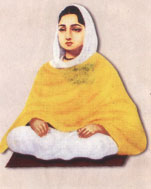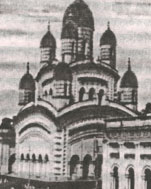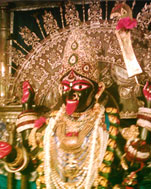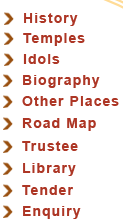| Social Backdrop of Bengal |
When India was still groping under the British rule trying hard to come to terms laid down by the English, the first wave of patriotism gripped the brave soldiers of Barrackpur, that shared the same river line where the Dakshineswar Temple would be built, led to the Sepoy Mutiny Revolt in 1857. Kolkata was the capital of the country and was then the second largest city of the British Empire only next to London. This new ardour of patriotic fervor soon spread amidst the important people of the city. Among them was the brave and deeply religious Rani Rashmoni who is one of the pioneers to silently revolt against the foreign rule.
|  |
| Dakshineswar in the Early 1800s and Before |
In the early 1800s, Dakshineswar was a small village along the eastern banks of the River Ganga. The picturesque details by J С Marshman in the January 1845 issue of Calcutta Review mentions “A little higher up we have the village of Dukhinsore, remarkable chiefly for the country seat, mapped down in the map of Hastie's Garden, but which has repeatedly changed hands during the last thirty years. To the north of it
|
 |
lies the Powder Magazine. During the last four years which have elapsed since Joseph’s map was published, four elegant houses have sprung up to the south of the garden.”
Dense forest surrounded the area where the famous Dakshineswar temple stands today. It was 300 years back when Durgaprasad Roy Choudhury and Bhavaniprasad Roy Choudhury, members of the renowned Savarna Roy Choudhury family settled here. Yogindranath one of the successors of this family was an ardent devotee of Sri Ramakrishna who later was known as Swami Yogananda.
|
| Rani Rashmoni, founder of the temple |
The famous Dakshineswar temple which houses the Goddess Kali was founded by Rani Rashmoni following a dream she saw when she was about to start on her pilgrimage to Benaras. A long term plan of the Rani materialized which she had longed to perform when her husband died with unfulfilled wish of constructing a Kali temple.
A dynamic woman, Rani Rashmoni took over the administration of the enormous estate her husband left her. The benevolent administrator, Rani Rashmoni was always in conflict with the stringent British laws and policies. People honored her and loved her for her daring and benevolent spirit. Dakshineswar temple, bathing ghats, a way from Subarnarekha River to Puri, Imperial Library (present National Library) and Hindu College (present Presidency College) are the testimonials to her benevolent nature.
|
| Expenditure on plot |
The dream had moved the Rani intensely and she instructed her trusted people specially her youngest son-in law to look for plots to construct the Kali Temple. After a massive hunt for suitable plots, a 20-acred plot in the village of Dakshineswar was selected. The land resembled a hump of a tortoise. One part of this land belonged to a European Christian while the other part was a Muslim burial ground. The Rani began to construct this Hindu temple in 1847 on this very ground thus integrating different faiths. The Deed of endowment states “In order to fulfill his wish, on 6th September 1847 I purchased 54.4 bighas of land at the cost of Rs. 42 thousand and 500 from James Hasty. I made to build a puca Navaratna temple, twelve Shiva temples (twelve jyotirlingam), a Vishnu temple and a Natmandir on the land. On 31st May 1855 I placed luxminarayan Shila in the Navaratna temple as per the wish of my late husband and also for the welfare of his soul.” The deed was executed on 31st May 1855.
Swami Saradananda mentioned in the Lilaprasanga, 'It is recorded in the Endowment document that the land of the Kali temple complex is 60 bighas.' In the paper itself, we come across the fact that the plot calculated to 54 1/2 bighas, with the surroundings of the Ganges in west, the land of Kashinath Roy Choudhury in east and the constructions of John Hastie in south. Later a part of the plot was used for a railway line and for the Vivekananda Bridge. So the current sum of the land mass is around 58 bighas.
|
| Installation of Ma Kali |
The idols of the Gods and the Goddess was decided to be installed on the ‘snana-yatra day’, an auspicious days of the Hindus. 31st May 1855, more than 1 lakh Brahmins were invited from different parts of the country to grace the auspicious occasion amidst the controversy of the Rani being in no position to own a temple and to offer Brahmins to feed since she was of low birth.
|  |
| Head priest selected |
Rani Rashmoni being aware of the problem discussed in length with the pundits, but none could solve her problem. Only Ramkumar Chattopadhayay,Sri Ramakrishna's elder brother
|
suggested that dedicating the temple to a Brahmin could overcome the existing problem.
The temple was dedicated in the name of Rani's Guru, and Ramkumar, was the head priest, who installed the idol of Kali in the new temple with a grand splendor on Thursday, 31st May, 1855. Many Intellectuals of shastras (scriptures), Brahmin pundits, and celebrated scholars arrived from distant places like Kashi, Orissa, and Navadvip.
Within a year he passed away leaving the entire responsibility to his younger brother, Ramakrishna, who during the subsequent thirty years became the seeker of the Goddess Kali and an ardent devotee who imbedded the seed of change in the socio-religious condition of Bengal and earned immense reputation for the Dakshineswar temple.
The exceptionally open-minded Rani wished that pilgrims of all casts and religions could offer prayers at the temple. Her dreams were fulfilled since irrespective of religion and castes Dakshineswar is thronged by millions of devotees and admired for its peaceful ambiance.
|
| Handover the legacy to the temple trust |
The Rani lived only for five years and nine months after the inauguration of the temple. She seriously fell ill in 1861. Realizing that death was approaching she decided to handover the property she purchased in Dinajput (now in Bangladesh) as a legacy for the maintenance of the temple to the temple trust. She accomplished her task on 18th February, 1861 and passed away on the subsequent day.
|
| | zzzzzzzzzzzzzzzzzzzzzzzzzzzzzzzzzzzzzzzzzzz | |




















Kali Mandir is very famouse in Kolkata, your blog information is very helpful to know about that tample. I am tour and travel services porvider inJim Corbett National Park
ReplyDelete